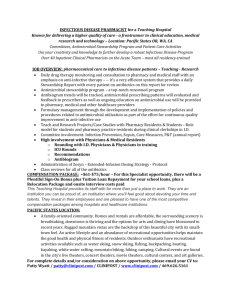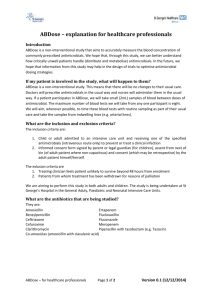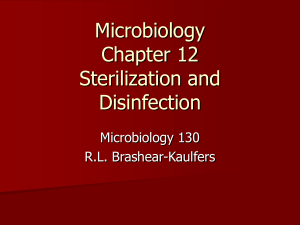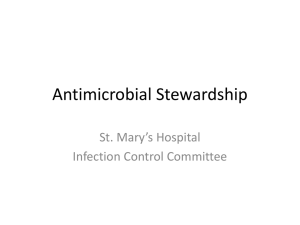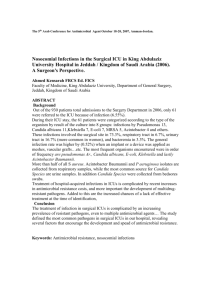Overview
advertisement
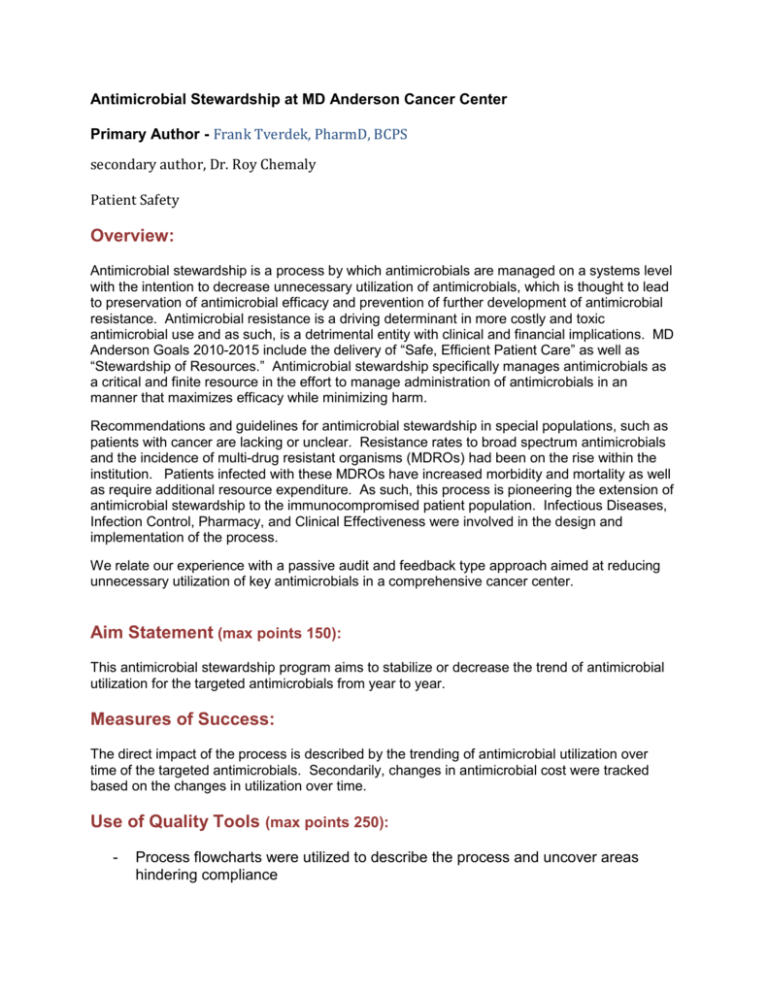
Antimicrobial Stewardship at MD Anderson Cancer Center Primary Author - Frank Tverdek, PharmD, BCPS secondary author, Dr. Roy Chemaly Patient Safety Overview: Antimicrobial stewardship is a process by which antimicrobials are managed on a systems level with the intention to decrease unnecessary utilization of antimicrobials, which is thought to lead to preservation of antimicrobial efficacy and prevention of further development of antimicrobial resistance. Antimicrobial resistance is a driving determinant in more costly and toxic antimicrobial use and as such, is a detrimental entity with clinical and financial implications. MD Anderson Goals 2010-2015 include the delivery of “Safe, Efficient Patient Care” as well as “Stewardship of Resources.” Antimicrobial stewardship specifically manages antimicrobials as a critical and finite resource in the effort to manage administration of antimicrobials in an manner that maximizes efficacy while minimizing harm. Recommendations and guidelines for antimicrobial stewardship in special populations, such as patients with cancer are lacking or unclear. Resistance rates to broad spectrum antimicrobials and the incidence of multi-drug resistant organisms (MDROs) had been on the rise within the institution. Patients infected with these MDROs have increased morbidity and mortality as well as require additional resource expenditure. As such, this process is pioneering the extension of antimicrobial stewardship to the immunocompromised patient population. Infectious Diseases, Infection Control, Pharmacy, and Clinical Effectiveness were involved in the design and implementation of the process. We relate our experience with a passive audit and feedback type approach aimed at reducing unnecessary utilization of key antimicrobials in a comprehensive cancer center. Aim Statement (max points 150): This antimicrobial stewardship program aims to stabilize or decrease the trend of antimicrobial utilization for the targeted antimicrobials from year to year. Measures of Success: The direct impact of the process is described by the trending of antimicrobial utilization over time of the targeted antimicrobials. Secondarily, changes in antimicrobial cost were tracked based on the changes in utilization over time. Use of Quality Tools (max points 250): - Process flowcharts were utilized to describe the process and uncover areas hindering compliance - - Histogram analysis of data review of 8 weeks of patient specific data was used as a snapshot to characterize the utilization of the antimicrobials and identify focus areas of intervention Control charts used to track utilization of targeted antimicrobials Interventions (max points 150 includes points for innovation): We targeted the following antibiotics in our intervention: meropenem, vancomycin, linezolid, daptomycin and tigecycline based on an initial assessment of utilization and resistance data. It was determined that a majority of the targeted antimicrobial use occurred in Leukemia, Stem Cell Transplant, Lymphoma/Myeloma, and ICU patients. Criteria for use for each drug was designed by a multi-disciplinary team of Hematology/oncology Critical care and Infectious Diseases physicians and pharmacists. These criteria consisted of defined indications for which the antimicrobial’s use was deemed appropriate. This criteria for appropriate usage was incorporated into the institution’s neutropenic fever guideline as well as the pneumonia and sepsis institutional algorithms- which are disseminated via the institutions internet site. An electronic daily list was created of the targeted drugs on the 5th day of therapy for patients being cared for by the targeted teams mentioned prior. Initially, an email was sent out every morning to all attending physicians with the list of patients on the 5th day of therapy of a targeted antimicrobial. The physicians were then instructed to discontinue the drug or fill out an orderset in the electronic medical record documenting an indication for continued use by choosing from the predetermined list of approved indications. An interim analysis schedule of every three months was utilized. Initial analysis showed a low compliance rate of ~30% (composite endpoint of discontinuation of drug or indication form filled out.) Therefore, the antimicrobial stewardship team petitioned the end users for feedback regarding the process. The resultant action was a more descriptive list of antimicrobial use criteria, as well as a modified process. An individualized email notification was sent to each inpatient attending physician with details about only their specific patients. In addition, patients in the ICU were also emailed to the ICU pharmacist. The physician/pharmacist was asked to again discontinue the antimicrobial or document the rationale for continuation via the electronic medical record. The details of the process and indications for appropriate use of each drug were disseminated via education to the affected departments during faculty meetings as well as via email notifications. Each email notification also contained instructions regarding compliance with the policy as well as reference to the institutional policy. The antimicrobial stewardship team encouraged feedback regarding the process by email as well as in follow-up discussions during departmental faculty meetings. One issue that was raised on numerous occasions was in regard to the role of Infectious Diseases consult and their partial responsibility for antimicrobial choice in consulted patients. As a result of another scheduled interim analysis, an ad-hoc committee was formed of 7 pharmacists which did a chart review of patients on targeted antimicrobials over a 6 week period to elucidate the role of infectious diseases in the management of the targeted antimicrobials. As a result of the findings, and as infectious diseases is in a position to influence prescribing by being a role model for antimicrobial use, a pilot email notification system was designed to notify the infectious diseases consultants of their patients which were on the 5th day of the targeted drugs. Using a novel email response system, the infectious diseases physicians began to respond to notifications and their compliance with the process was tracked. While there exists many successful antimicrobial stewardship programs this particular program is innovative in that we provided stewardship to a patient population often excluded from these type of interventions due to the tenuous nature of their immune system. Many programs restrict antimicrobials up front, however, given the fear of rapid deterioration of these patients should they not get appropriate antimicrobials we opted for an intervention later in the course of therapy. Our results confirm that reduction in unnecessary antimicrobials can be performed without strict restriction practices. Results (max points 250): Compliance in the most recent interim analysis: Infectious Diseases compliance during the pilot phase was 92%. Monthly data on antibiotic usage and costs were obtained for the pre-intervention (Oct. 2007 – Oct. 2010) and post-intervention (Nov. 2010 – Jun. 2012) periods. The segmented regression analysis of interrupted time series was used to assess the significance of changes of antibiotic use and costs. (Utilizing “QI Analayst” software) Definition: DDD: defined daily dose per WHO(World health Organization) definition for each drug WAC: Wholesale acquisition cost. Revenue Enhancement /Cost Avoidance / Generalizability (max points 200): In 2011 the program was associated with a cost savings for 4 out of the 5 drugs targeted; net cost savings from 2010 to 2011 was $1.25 million. This was validated by evaluating the wholesale acquisition per year as compared to the actual purchase history of the targeted antimicrobials. It is important to note that meropenem cost per unit decreased during 2010 and is partially responsible for decreases in cost. Conversely, daptomycin unit price increased yielding a net increase in cost despite a slight over all decrease in utilization. The substantial cost savings associated with the program has prompted an effort to expand it to areas outside of the departments currently involved; recently the program was extended to include general internal medicine and gastro-intestinal medical oncology. Conclusions and Next Steps: This project was successful in increasing compliance with the process in a step-wise manner. The success was due in part to the critical feedback given by the end users as well as the scheduled interim analyses that occurred as a result of such feedback. Objective verification of said problems through chart review when needed, as well as the ability to adapt the program as each problem was identified were critical. Regarding the primary aim, the program was associated with a positive impact on the utilization of targeted antimicrobials. The program was associated with a decreased mean duration of therapy for the targeted antimicrobials and the overall usage (DDD/1000 pt days). Additionally, this decreased utilization contributed to a cost savings. Moving forward, the plan is to extend the novel email notification/response system beyond infectious diseases to all targeted physicians. In addition, the program itself will be expanded to include patient services in the hospital that are not currently receiving notification. Furthermore, active follow-up on Days 6 and days 14 of therapy will be conducted by the antimicrobial stewardship team to promote compliance with the process. Consideration is also being given to the inclusion of other targeted drugs. While antimicrobial utilization and cost avoidance are key measures of success, ultimately the impact on antimicrobial resistance is desired. Antimicrobial resistance on a hospital wide scale may take years to change, however, given that the program is going on 2 years, there will soon be opportunity to address these endpoints.
